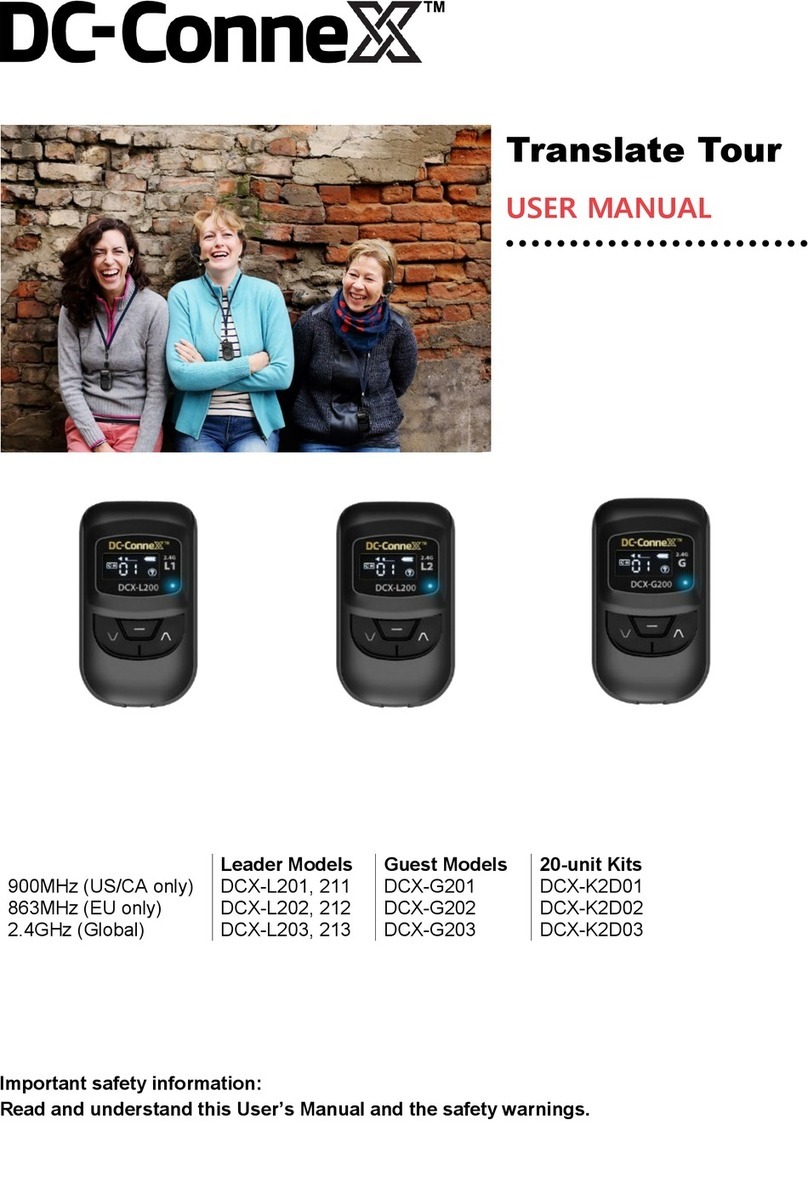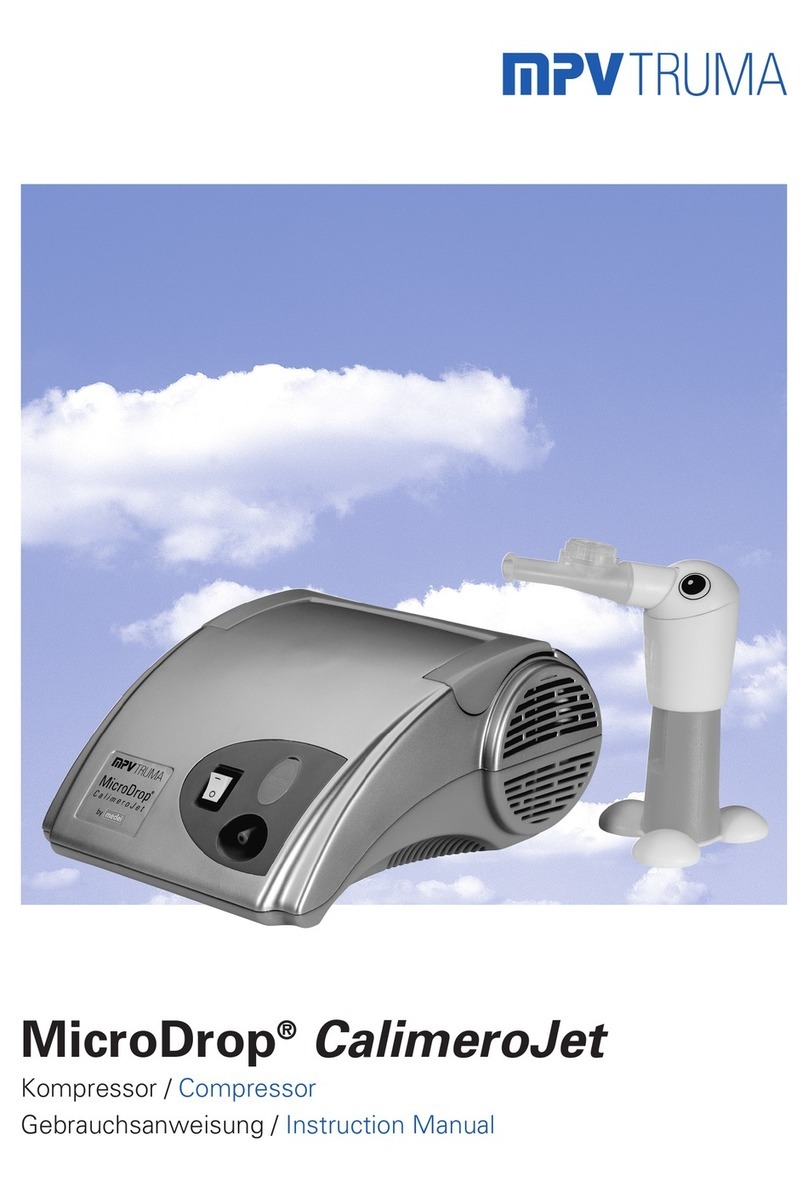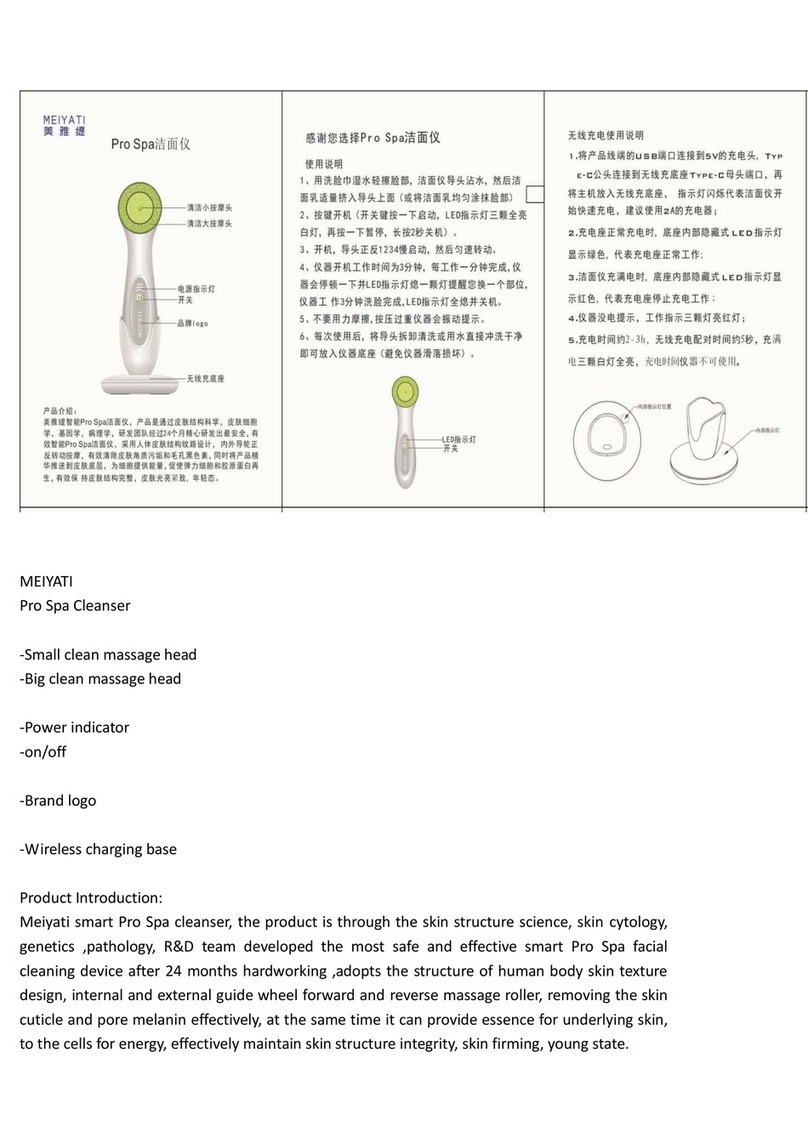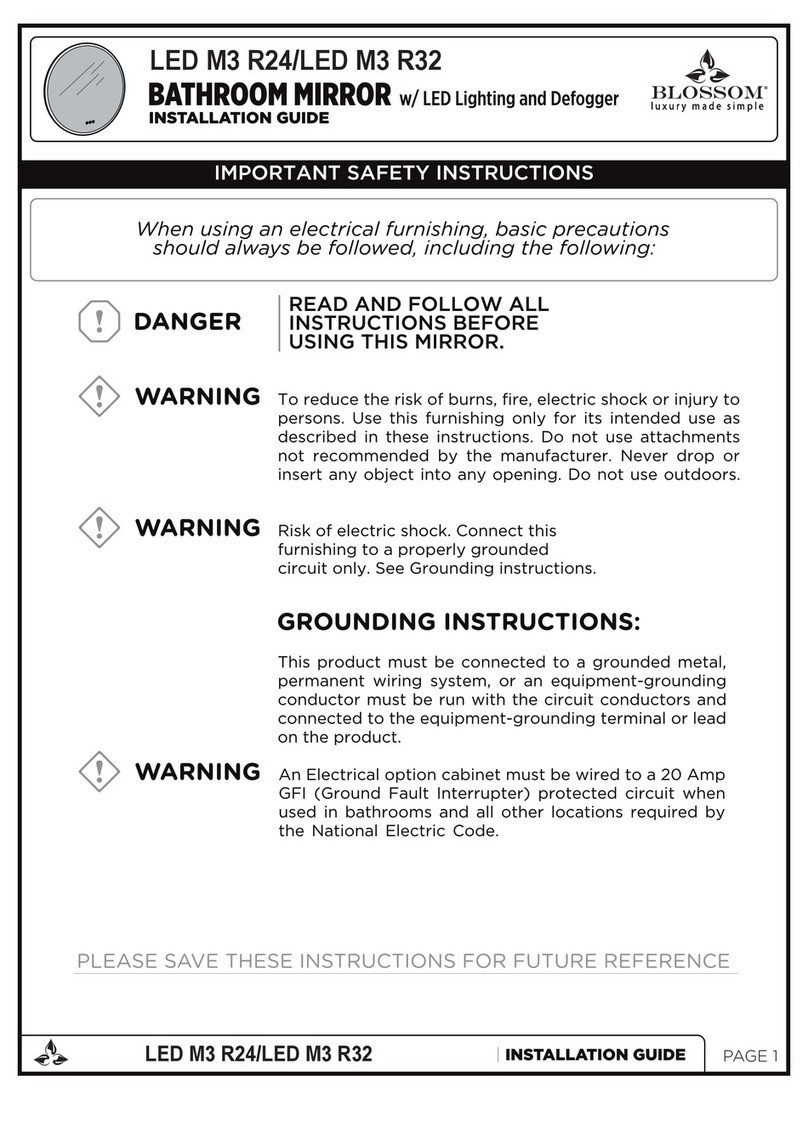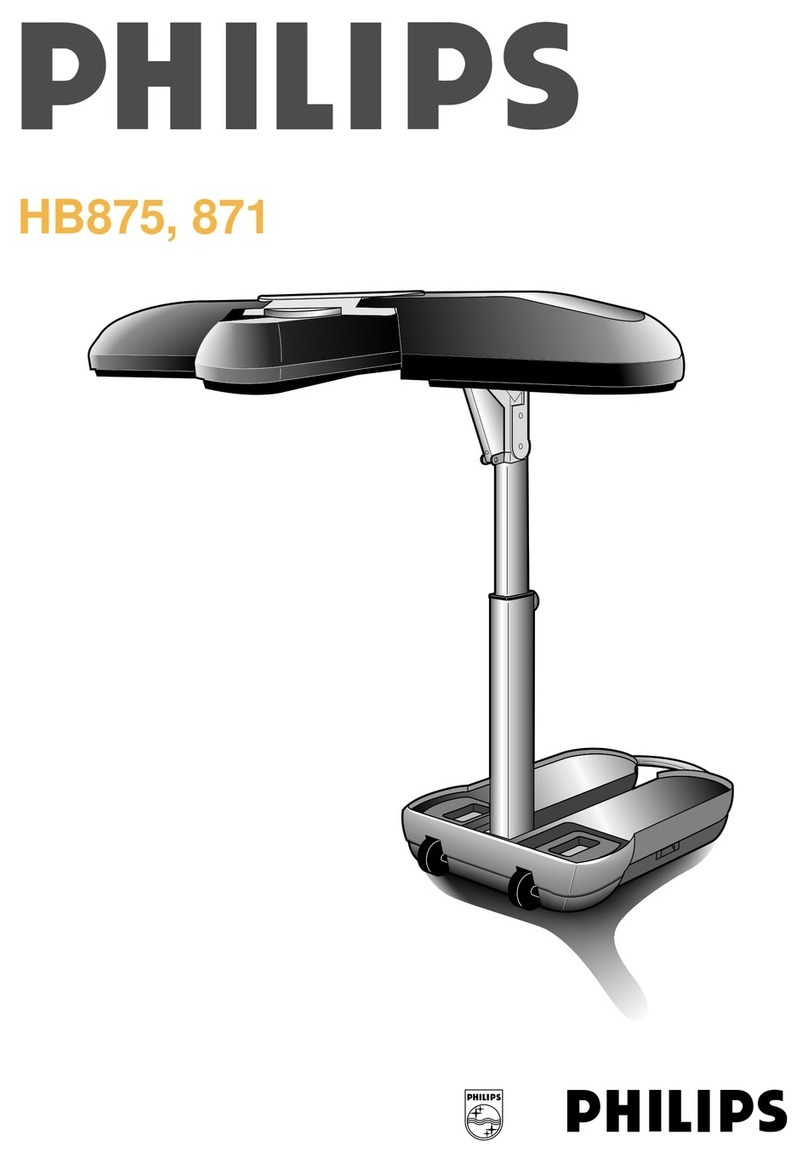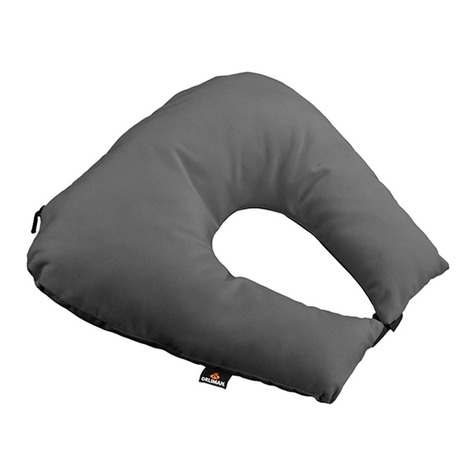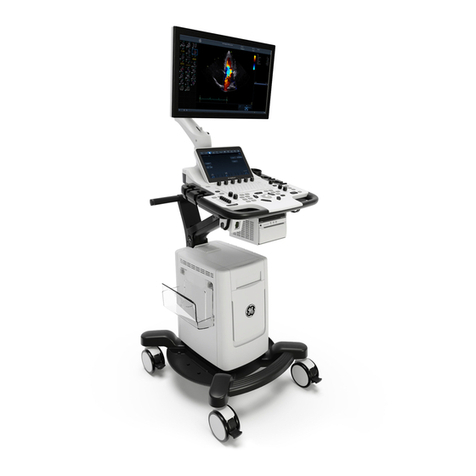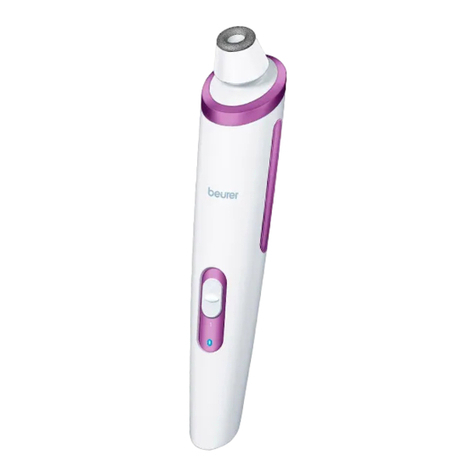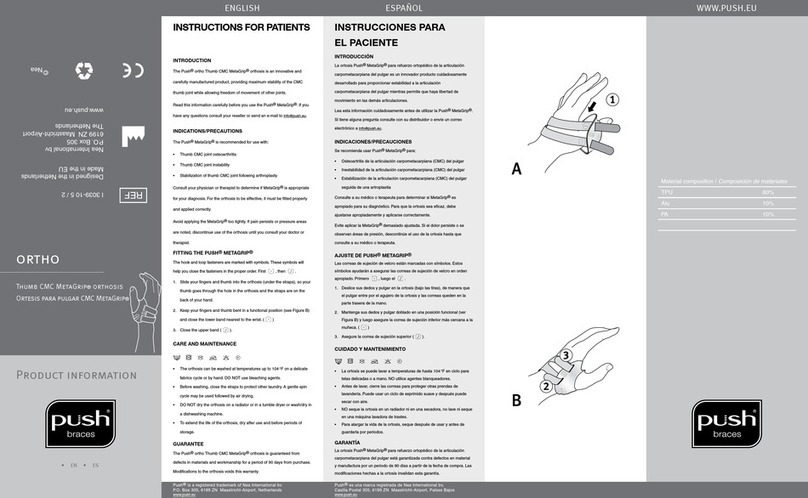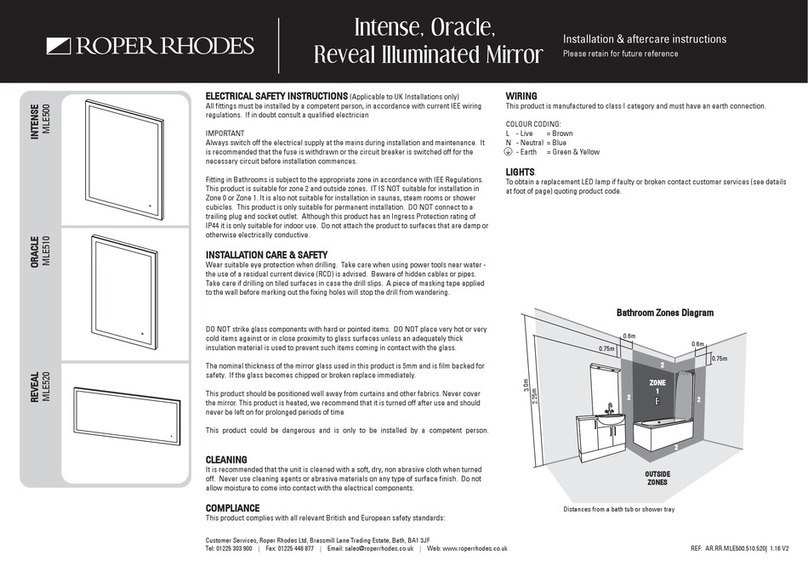Nonin 2500A PalmSAT User manual

Operator’s Manual
Model 2500A PalmSAT®
Pulse Oximeter with Alarms
0123
0123
English

.
Nonin®reserves the right to make changes and improvements to this manual and the products it
describes at any time, without notice or obligation.
Nonin Medical, Inc.
13700 1st Avenue North
Plymouth, Minnesota 55441-5443 USA
+1 (763) 553-9968
(800) 356-8874 (USA and Canada)
Fax: +1 (763) 553-7807
E-mail: [email protected]
Nonin Medical B.V.
Prins Hendriklaan 26
1075 BD Amsterdam, Netherlands
+31 (0)13 - 79 99 040 (Europe)
Fax: +31 (0)13 - 79 99 042
E-mail: [email protected]
nonin.com
Authorized EC Representative:
MPS, Medical Product Service GmbH
Borngasse 20
D-35619 Braunfels, Germany
References to “Nonin” in this manual shall imply Nonin Medical, Inc.
Nonin, PalmSAT, PureLight and nVISION are registered trademarks or trademarks of Nonin
Medical, Inc.
Microsoft®and Windows®are registered trademarks of Microsoft Corporation.
© 2013 Nonin Medical, Inc.
7923-101-03
CAUTION: Federal law (USA) restricts this device to sale by or on the order of a
licensed practitioner.
Consult Instructions for Use.
01230123
EC
REP

i
Contents
Indications for Use ........................................................................................ 1
Contraindications.................................................................................................... 1
Warnings ................................................................................................................ 1
Cautions ................................................................................................................. 2
Guide to Symbols .......................................................................................... 4
Displays and Indicators ................................................................................ 5
SpO2Display .......................................................................................................... 5
Pulse Rate Display ................................................................................................. 5
Pulse Quality Display.............................................................................................. 5
Low Battery Indicator.............................................................................................. 5
Sensor Fault Display .............................................................................................. 5
Alarm Bar................................................................................................................ 6
Alarm Silence Indicator........................................................................................... 6
Pulse Rate Tone..................................................................................................... 6
Using the PalmSAT Pulse Oximeter ............................................................ 7
Unpacking the Model 2500A .................................................................................. 8
Installing and Using the Batteries ........................................................................... 8
Important Notes about Battery Use ...................................................................... 10
With AA Batteries.............................................................................................. 10
With Rechargeable NiMH Battery Pack ............................................................ 10
Recharging Batteries (NiMH Battery Pack only)................................................... 10
Connecting the Sensor ......................................................................................... 10
Power On/Off........................................................................................................ 11
Power On Self-Test .............................................................................................. 11
Monitoring............................................................................................................. 12
Detailed Operation....................................................................................... 13
Setup Mode .......................................................................................................... 13
Entering Setup Mode ........................................................................................ 13
Making Selections in Setup Mode..................................................................... 13
Care and Maintenance................................................................................. 15
Alarm Functions .......................................................................................... 16
High and Medium Priority Alarms ......................................................................... 16
Adjusting Alarm Settings ...................................................................................... 17
Recalling Previous Alarm Settings ....................................................................... 17
Reviewing Alarm Settings..................................................................................... 18
Silencing Audible Alarms...................................................................................... 18
System Fault Alarms ............................................................................................ 18
Memory Functions....................................................................................... 19
Memory Playback ................................................................................................. 19

ii
Contents (Continued)
Playing Back the Data Stored in Memory..........................................................19
Clearing the Memory.............................................................................................20
Choosing Memory Clear Settings......................................................................20
Choosing Calendar and Clock Settings ................................................................20
Communications ..........................................................................................21
Serial Output .........................................................................................................21
Service, Support and Warranty...................................................................22
Warranty................................................................................................................23
Parts and Accessories.................................................................................24
Troubleshooting ...........................................................................................25
Technical Information ..................................................................................28
Manufacturer’s Declaration ...................................................................................28
Equipment Response Time...................................................................................31
Testing Summary ..................................................................................................32
SpO2Accuracy Testing .....................................................................................32
Pulse Rate Motion Testing.................................................................................32
Low Perfusion Testing .......................................................................................32
Principles of Operation..........................................................................................33
Specifications ........................................................................................................33

iii
Figures
Figure 1. Displays, Indicators and Buttons................................................................. 7
Figure 2. Rear View.................................................................................................... 8
Figure 3. Installing Batteries....................................................................................... 9
Figure 4. Connecting a Sensor................................................................................. 11

iv
Tables
Table 1. Labeling Symbols......................................................................................... 4
Table 2. Adjustable Parameters and Settings.......................................................... 13
Table 3. High and Medium Priority Alarms .............................................................. 16
Table 4. Alarm Limits ............................................................................................... 17
Table 5. Pulse Oximeter Sensor Connector Pin Assignments................................. 21
Table 6. Electromagnetic Emissions........................................................................ 28
Table 7. Electromagnetic Immunity.......................................................................... 29
Table 8. Guidance and Manufacturer’s Declaration—Electromagnetic Immunity.... 30
Table 9. Recommended Separation Distances ....................................................... 31

1
Indications for Use
Indications for Use
The Nonin®Model 2500A PalmSAT®Pulse Oximeter with Alarms is indicated for use in measuring
and displaying functional oxygen saturation of arterial hemoglobin (SpO2) and pulse rate for adult,
pediatric, and neonatal patients. The device is intended for continuous monitoring and/or spot-
checking of patients during both motion and no-motion conditions, and for patients who are well
or poorly perfused.
Contraindications
Do not use this device in an MR environment.
Explosion Hazard: Do not use in an explosive atmosphere or in the presence of flammable anesthetics or
gasses.
This device is not defibrillation proof per IEC 60601-1.
Warnings
This device is intended only as an adjunct in patient assessment. It must be used in conjunction with other
methods of assessing clinical signs and symptoms.
Oximeter readings of this device may be affected by the use of an electrosurgical unit (ESU).
Inspect the sensor application site at least every 6 to 8 hours to ensure correct sensor alignment and skin
integrity. Patient sensitivity to sensors and/or double-backed adhesive strips may vary due to medical status or
skin condition.
Use only with Nonin-branded PureLight®pulse oximeter sensors. These sensors are manufactured to meet the
accuracy specifications for Nonin Pulse Oximeters. Using other manufacturers’ sensors may cause improper
pulse oximeter performance. Using other manufacturers’ sensors can result in improper pulse oximeter
performance.
Do not use a damaged sensor. If the sensor is damaged in any way, discontinue use immediately and replace
the sensor.
As with all medical equipment, carefully route patient cabling to reduce the possibility of patient entanglement or
strangulation.
This device should not be used adjacent to or stacked with other equipment. If adjacent or stacked use is
necessary, the device should be observed carefully to verify normal operation.
The use of accessories, sensors, cables, and power supplies other than those specified in the Parts and
Accessories List may result in increased electromagnetic emission and/or decreased immunity of this device.
This device must be able to measure the pulse properly to obtain an accurate SpO2measurement. Verify that
nothing is hindering the pulse measurement before relying on the SpO2measurement.
Operation of this device below the minimum amplitude of 0.3% modulation may cause inaccurate results.
Discontinue use of adhesive tape strips if the patient exhibits an allergic reaction to the adhesive material.
Avoid excessive pressure to the sensor application site as this may cause damage to the skin beneath the
sensor.

2
Indications for Use
Because operating environments vary, use caution to ensure that all audible alarms and indicators can be heard.
Users must determine the acceptable audible distance of all alarms.
Do not place this device in an environment where its speaker opening may become blocked; alarms may
become muffled or inaudible.
Turning off the alarm volume creates a situation that is not compliant with relevant safety standards. The alarm
silence indicator is lit solid when the alarm volume is turned off or set below 45 dBA.
When a system fault occurs, the patient will no longer be monitored.
To comply with relevant product safety standards, ensure that all alarm volumes are set appropriately and are
audible in all situations. Do not cover or otherwise hinder any speaker openings.
The device turns off after approximately 10 minutes when at low battery capacity.
Before changing the batteries, make sure the device is off and the sensor is not attached to a digit.
Cautions
Before use, carefully read the package insert provided with the sensors.
This device is not an apnea monitor.
Verify that all visible indicators illuminate and that an audible indicator sounds during the startup (initialization)
sequence. If any indicator is not lit or the audible indicator does not sound, do not use the device. Contact Nonin
Technical Service for assistance.
The presence of a defibrillator may interfere with the performance of this device.
This device may not work on all patients. If you are unable to achieve stable readings, discontinue use.
This device has motion tolerant software that minimizes the likelihood of motion artifact being misinterpreted as
good pulse quality. In some circumstances, however, the device may still interpret motion as good pulse quality.
Minimize patient motion as much as possible.
Ear Clip and Reflectance sensors are not recommended for pediatric or neonatal use. The accuracy of these
sensors has not been established for pediatric or neonatal use.
Do not autoclave or immerse the device or sensors in liquid. Do not expose the device or components to
excessive moisture or liquids.
Do not use caustic or abrasive cleaning agents on the device or the sensors.
The oximeter sensor might not work on cold extremities due to reduced circulation. Warm or rub the finger to
increase circulation, or reposition the sensor.
Replace the batteries as soon as possible after a low-battery indication. Always replace the batteries with fully
charged batteries.
Use only Nonin-specified battery types with this device.
Do not use fully charged and partially charged batteries at the same time. This may cause the batteries to leak.
Warnings (Continued)

3
Indications for Use
Do not remove any covers other than the battery cover when replacing batteries. There are no user-serviceable
parts inside other than the replaceable batteries.
Follow local, state and national governing ordinances and recycling instructions regarding disposal or recycling
of the device and device components, including batteries.
Batteries may leak or explode if used or disposed of improperly.
Remove the batteries if the device will be stored for more than 1 month.
This equipment complies with IEC 60601-1-2 for electromagnetic compatibility for medical electrical equipment
and/or systems. This standard is designed to provide reasonable protection against harmful interference in a
typical medical installation. However, because of the proliferation of radio-frequency transmitting equipment and
other sources of electrical noise in healthcare and other environments, it is possible that high levels of such
interference due to close proximity or strength of a source might disrupt the performance of this device. Medical
electrical equipment needs special precautions regarding EMC, and all equipment must be installed and put into
service according to the EMC information specified.
In compliance with the European Directive on Waste Electrical and Electronic Equipment (WEEE) 2002/96/EC,
do not dispose of this product as unsorted municipal waste. This device contains WEEE materials; please
contact your distributor regarding take-back or recycling of the device. If you are unsure how to reach your
distributor, please call Nonin for your distributor’s contact information.
This device’s display will go blank after 30 seconds of inadequate signals. The data update period is every
1.5 seconds.
Portable and mobile RF communications equipment can affect medical electrical equipment.
This device is designed to determine the percentage of arterial oxygen saturation of functional hemoglobin.
Factors that may degrade pulse oximeter performance or affect the accuracy of the measurement include the
following:
A functional tester cannot be used to assess the accuracy of a pulse oximeter monitor or sensor.
All parts and accessories connected to the serial port of this device must be certified according to at least IEC
60950 or UL1950 for data-processing equipment.
This device is a precision electronic instrument and must be repaired by trained Nonin personnel only. Field
repair of the device is not possible. Do not attempt to open the case or repair the electronics. Opening the case
may damage the device and void the warranty.
Any sign or evidence of opening the system, field service by non-Nonin personnel, tampering, or any kind of
misuse or abuse of the system, shall void the warranty in its entirety.
Replace batteries within 30 seconds to avoid losing settings (date, time, and patient data stored in memory) or
corrupting data.
Cautions (Continued)
- excessive ambient light
- excessive motion
- electrosurgical interference
- blood flow restrictors (arterial catheters, blood pressure
cuffs, infusion lines, etc.)
- moisture in the sensor
- improperly applied sensor
- incorrect sensor type
- inadequate signal
- venous pulsations
- anemia or low hemoglobin concentrations
- cardiogreen and other intravascular dyes
- carboxyhemoglobin
- methemoglobin
- dysfunctional hemoglobin
- artificial nails or fingernail polish
- a sensor not at heart level.

4
Guide to Symbols
Guide to Symbols
This table describes the symbols that are found on the Model 2500A and in this manual.
Table 1: Labeling Symbols
Symbol Description
CAUTION!
Consult Instructions for Use.
Follow Instructions for Use.
Type BF Applied Part (Patient isolation from electrical shock).
UL Mark for Canada and the United States with respect to electric shock, fire, and
mechanical hazards only in accordance with UL 60601-1 and CAN/CSA-C22.2 No.
601.1.
CE Marking indicating conformance to EC directive No. 93/42/EEC concerning
medical devices.
Serial Number (located under the back cover).
IPX2 Protected against vertically falling water drops when enclosure is tilted up to 15
degrees per IEC 60529.
IP32
Protected against vertically falling water drops when enclosure is tilted up to
15 degrees and ingress of solid foreign objects greater than or equal to 2.5 mm
(0.1 in.) in diameter per IEC 60529.
Indicates separate collection for electrical and electronic equipment (WEEE).
Authorized Representative in the European Community.
%SpO2%SpO2Display
Pulse Rate Display
Pulse Quality Display
Low Battery LED
Alarm Silence LED
Front Panel Buttons
On/Off
Advance
!
C
L
A
S
S
I
F
I
E
D
US
CU
L
01230123
SN
EC
REP

5
Displays and Indicators
Displays and Indicators
SpO2Display
The SpO2display is the upper numeric display (identified by the %SpO2symbol). This 3-digit
light-emitting diode (LED) display shows the current oxygen saturation percentage. This display
flashes for SpO2alarms.
Pulse Rate Display
The Pulse Rate display is the lower numeric display (identified by the symbol). This 3-digit
LED display shows the pulse rate in pulses per minute. This display flashes for Pulse Rate alarms.
Pulse Quality Display
The Pulse Quality display (identified by the symbol) is a tricolor LED that blinks once for each
detected pulse. The Pulse Quality display changes color to indicate changes in the pulse
waveform signal that may affect the SpO2data. It may blink green, amber or red.
•Green indicates a good pulse strength
•Amber indicates a marginal pulse strength. To improve signal quality, reposition the
sensor, try a different sensor type, eliminate patient movement, or improve the site’s
circulation.
•Red indicates an inadequate pulse strength. While the Pulse Quality display is red, SpO2
and pulse rate values are not updated. After about 10 seconds, the values are replaced
with dashes, indicating that readings are not possible.
Low Battery Indicator
Low and critically low battery capacity is indicated with a flashing Low Battery indicator and a
medium priority alarm. When batteries are critically low, the digital displays will go blank, and the
Pulse Quality display will blink amber or red, but not green. Any SpO2or pulse rate alarms in effect
when critically low battery capacity is reached will be latched, and flashing dashes will appear on
the corresponding display. After 10 minutes at critically low battery capacity, the pulse oximeter will
shut off automatically.
Sensor Fault Display
If the device determines that a sensor fault exists (a sensor disconnect, failure, misalignment or
incapatability with the monitor) or if a pulse oximeter sensor signal is no longer detected, a dash
(-) appears in the left-most digit of the SpO2display. The readings that are displayed will freeze for
10 seconds if the pulse oximeter sensor fault or the inadequate signal continues. A sensor fault is
a medium priority alarm.
If the sensor fault or the inadequate signal is not corrected, the frozen readings and the left-most
dash will be replaced by dashes in the middle digit of both the SpO2and the Pulse Rate displays,
10 seconds after the first dash appeared.
When the sensor fault or the inadequate signal is corrected, the SpO2and pulse rate displays will
return to normal operation.

6
Displays and Indicators
Alarm Bar
The Alarm Bar flashes amber or red, indicating medium or high priority alarms, respectively. This
indicator is located near the top of the device.
Alarm Silence Indicator
The Alarm Silence indicator (identified by the symbol) is located to the left of the On/Off button.
Whenever the Alarm Silence indicator is flashing, all audible alarms are temporarily silenced. If
the alarm volume is set to “off,” the Alarm Silence indicator is lit solidly.
Pulse Rate Tone
When the Pulse Rate tone is active, a beep sounds for each detected pulse. This beep changes
in pitch with SpO2values. The default volume is OFF. During normal operation, the volume can
be changed (off, low, or high) by momentarily pressing the advance button.

7
Using the PalmSAT Pulse Oximeter
Using the PalmSAT Pulse Oximeter
The Model 2500A PalmSAT is a digital handheld pulse oximeter that displays numerical values for
blood oxygen saturation (%SpO2) and pulse rate. It provides audible and visual alarms for both
medium and high priority conditions.
This device will typically operate for 60 hours continuously between alkaline battery replacements,
or for 40 hours with the Model 2500B Rechargeable NiMH (Nickel Metal Hydride) Battery Pack
(optional). The device requires no routine calibration or maintenance other than replacement of
alkaline batteries or recharging the optional battery pack with the Model 2500C Charger Stand
(refer to the Model 2500C Operator’s Manual).
The pulse oximeter determines functional oxygen saturation of arterial hemoglobin (SpO2) by
measuring the absorption of red and infrared light passing through perfused tissue. Changes in
absorption caused by the pulsation of blood in the vascular bed are used to determine oxygen
saturation and pulse rate.
Figure 1: Displays, Indicators and Buttons
Oxygen saturation and pulse rate values are displayed by light-emitting diode (LED) digital
displays. On each detected pulse, the Pulse Quality display blinks. Patient pulse quality signals
are graded as good, marginal, or inadequate and are indicated as such by the Pulse Quality
display blinking green, amber or red, respectively. This simple method gives the user a pulse-by-
pulse visual indication of waveform signal quality without requiring the user to perform complex
waveform analysis.
SpO2
Display
On / Off Button
Pulse Quality
Display (Tricolor)
Pulse Rate
Display
Pulse Oximeter
Sensor
Connector
Advance Button
Low Battery
Indicator
Alarm Bar
(Bicolor)
Speaker
Alarm Silence
Indicator

8
Using the PalmSAT Pulse Oximeter
The Model 2500A Pulse Oximeter may be used with a variety of Nonin-branded PureLight pulse
oximeter sensors.
A sensor disconnect or malfunction is indicated by an inadequate Pulse Quality display blinking
and/or a dash to the left of the SpO2value on the LED display. When adequate pulse signals are
not received, the SpO2and/or pulse rate numerical values will be replaced by dashes. Low and
critically low battery conditions will be indicated by the Low Battery indicator.
Figure 2: Rear View
Unpacking the Model 2500A
The Model 2500A complete system includes the following items:
• 1 Model 2500A Pulse Oximeter
• 1 Model 2500A Operator’s Manual on CD
• 1 Nonin Pulse Oximeter Sensor
• 4 AA-Size Alkaline Batteries
Confirm that the items listed are packed with the system. If any item on this list is missing or
damaged, contact your distributor. Contact the carrier immediately if the shipping carton is
damaged.
Installing and Using the Batteries
The Model 2500A can be powered by 4 AA-size alkaline batteries, or by the optional
Rechargeable NiMH Battery Pack, Model 2500B.
CAUTION: Use only Nonin-specified battery types with this device.
5822-500-04
UL 60601-1
US PATENT # Re. 33,643
PULSE OXIMETER
MODEL 2500A
PLYMOUTH, MN USA
NONIN MEDICAL, INC.
4 X 1.5V AA
IEC LR6
C
L
A
S
S
I
F
I
E
D
US
CUL0123
IP32
30EM
See Accompanying
Documents
Battery Cover
Latch
Battery
Cover
!

9
Using the PalmSAT Pulse Oximeter
Low and critically low battery capacity is indicated with a flashing Low Battery indicator and a
medium priority alarm. When batteries are critically low, the digital displays will go blank, and the
Pulse Quality indicator will blink amber or red, but not green. Any SpO2or pulse rate alarms in
effect when critically low battery capacity is reached will be latched, and flashing dashes will
appear on the corresponding display. After 10 minutes at critically low battery capacity, the pulse
oximeter will shut off automatically.
.
1. Press the battery cover latch, and remove the battery cover on the bottom of the unit.
2. Insert four new AA-size alkaline batteries or a Rechargeable NiMH Battery Pack. Be
sure to insert the batteries in the correct position, as indicated by the polarity markings
(+ and -) inside the battery compartment. Proper battery positioning is essential for
correct operation.
3. Replace the battery cover and turn on the device. If the unit does not turn on, see
“Troubleshooting.”
Figure 3: Installing Batteries
WARNING: The device turns off after approximately 10 minutes when at critically low
battery capacity.
WARNING: Before changing the batteries, make sure the device is off and the sensor
is not applied to a digit.
CAUTION: Replace the batteries as soon as possible after a low-battery indication.
Always replace the batteries with fully charged batteries.
CAUTION: Replace batteries within 30 seconds to avoid losing settings (date, time,
and patient date stored in memory) or corrupting data.
!
!
Battery
Orientation
AA-size
Alkaline
Batteries
Battery Pack

10
Using the PalmSAT Pulse Oximeter
Important Notes about Battery Use
Four AA alkaline batteries provide the device with approximately 60 hours of continuous operation,
while the Rechargeable NiMH Battery Pack provides approximately 40 hours of continuous operation.
Clock/calendar settings can significantly affect battery storage life. Batteries drain during
storage, but they drain much more quickly when the unit’s clock/calendar functions are set. Refer
to “Clock and Calendar Settings” for more information.
With AA Batteries
• If the clock/calendar is not set when the unit is stored, alkaline batteries will need
replacement in 10-12 months if the unit has not been used.
• If the clock/calendar is set when the unit is stored and if the unit has not been used,
alkaline batteries will require replacement in about 6 weeks.
• Using the oximeter will shorten the required replacement time.
With Rechargeable NiMH Battery Pack
• If the clock/calendar is not set when the unit is stored, and if the unit has not been used,
the Rechargeable NiMH Battery Pack will need recharging at least every 2 months.
• If the clock/calendar is set when the unit is stored, and if the unit has not been used, the
Rechargeable NiMH Battery Pack will need recharging at least every 3 weeks.
• Using the oximeter will shorten the required recharging time.
Recharging Batteries (NiMH Battery Pack only)
• Completely recharging the NiMH battery pack requires approximately 180 minutes when
the unit is completely discharged.
• The expected useful life of the Rechargeable NiMH battery pack is 500 charge/
discharge cycles, or approximately 10 years, whichever is first. The battery pack must
be charged at least once each year to maintain optimal battery life.
• AA alkaline batteries cannot be recharged in the charging stand.
Connecting the Sensor
Connect the pulse oximeter sensor (with the Nonin logo facing up) to the top of the device as
shown. Ensure that the sensor is firmly plugged in. Refer to “Specifications” or to the specific
sensor package insert for pulse oximeter sensor positioning information.

11
Using the PalmSAT Pulse Oximeter
Figure 4: Connecting a Sensor
Power On/Off
•Turn on the device by pressing and releasing the On/Off button on the front of the unit.
•
Turn off
the device by pressing and holding the On/Off button for approximately 2 seconds.
To conserve battery life, the device automatically powers off after 10 minutes of inactivity. Inactivity
is indicated by dashes on the displays and may result from an improperly connected or positioned
sensor, or from an inadequate patient pulse signal.
Power On Self-Test
When the Model 2500A is turned on for normal operation, the unit will cycle through a startup/
initialization sequence before displaying valid data. During startup, always check for any missing
indicators or LED display segments and ensure that the audible indicator sounds. If any indicator is
not functioning, do not use the device. Contact Nonin Technical Service for repair or replacement.
During its normal startup sequence, the device will cycle as follows:
•“888 888” appears briefly in the SpO2and Pulse Rate displays.
• the amber Low Battery and Alarm Silence indicators turn on steadily for a few seconds.
• the Pulse Quality display turns red for 1 second, then green for 1 second, then shuts off,
while the Alarm Bar turns red for 1 second, then amber for 1 second.
• the clock time currently set in the memory (in hours and minutes, 04 41 for example)
appears briefly in the displays.
• the software revision numbers (display in the following order, each for approximately
1 second): Main revision “r” + 3 digits; Memory revision “n” “n” (for m) + 3 digits; Sound
revision “s” + 3 digits.
• three audible beeps sound.
• (two dashes) appear in the displays until a valid pulse signal is detected.
NOTES:
• The two-minute alarm silence feature is automatically enabled immediately after the startup
sequence.
• This startup sequence varies slightly when entering setup mode at power on.

12
Using the PalmSAT Pulse Oximeter
Monitoring
Verify that the pulse oximeter sensor is properly positioned on the patient. Ensure that the pulse
oximeter is sensing adequate pulse quality by:
• verifying that the Pulse Quality display is blinking green and
• verifying that the Pulse Rate and SpO2displays are displaying readings and
• verifying that blinking of the Pulse Quality display is in time with the pulse rate for at least
10 seconds
If the Pulse Quality display is blinking red or amber or is blinking erratically, reposition the sensor
or replace the sensor.
If the sensor is not properly positioned, or no sensor is attached to the pulse oximeter after startup
(a few seconds after powering on), both the SpO2 and Pulse Rate displays will display a single
dash until a valid pulse signal is detected.

13
Detailed Operation
Detailed Operation
All functions of the Model 2500A are controlled by the On/Off and Advance buttons located
on the front of the unit.
Setup Mode
Setup mode is used to adjust alarm, memory clear, and memory playback functions, as well as to
set the calendar and clock. In Setup mode, the Advance and On/Off buttons are used to make all
selections.
NOTE: Setting the month to “00” disables the calendar and clock functions and helps
conserve battery life.
Entering Setup Mode
1. With the unit off, press and hold the Advance button while pressing and then
releasing the On/Off button.
2. Release the advance button when 888 888 is displayed on the SpO2and Pulse
Rate displays. The clock time currently set in the memory, 04 41 for example,
appears briefly in the displays, and then rCL no appears.
Making Selections in Setup Mode
1. When entering Setup mode, rCL no is displayed. (This indicates that Recall Alarms
is the setting being adjusted, and that the default value is “no.” See Table 2.) Press
and release the Advance button to change the value for this setting (or press and
hold the Advance button to scroll quickly through the range of adjustable values).
2. When the desired value appears, press and release the On/Off button to store the
value and advance to the next adjustable parameter, as listed in the following table.
3. Continue this process until all settings are chosen.
When the setting sequence is complete, the device exits Setup mode, automatically displays the
alarm settings in effect, and is then ready to begin normal operation.
Table 2: Adjustable Parameters and Settings
Setting Appears in SpO2
Display
Range of Values Appears
in Pulse Rate Display
Default
Value
Recall Alarm Settings1rCL yes or no no
SpO2Low Alarm 02L 50 - 95, 0FF 85
Heart Rate High Alarm H H 75 - 275, 0FF 200
Heart Rate Low Alarm H L 30 - 110, 0FF 50

14
Detailed Operation
SpO2High Alarm 02H 80 - 100, 0FF 0FF
Audible Alarms Adb Hi, Lo, 0FF Hi
Memory Clear2CLr yes or no no
Delete (confirm clear) dEL yes or no no
Year y00- 99 07
Month nn 00 - 12 00
Day d01- 31 00
Hour h00- 23 00
Minute nn 00 - 59 00
Notes:
1) Choosing “yes” for rCL (Recall Alarm Settings) will recall previous alarm settings and exit setup
mode.
2) Choosing “yes” for both the CLr and dEL settings (the memory clear function) will clear the
memory and exit setup mode.
Table 2: Adjustable Parameters and Settings (Continued)
Setting Appears in SpO2
Display
Range of Values Appears
in Pulse Rate Display
Default
Value
Other manuals for 2500A PalmSAT
1
Table of contents
